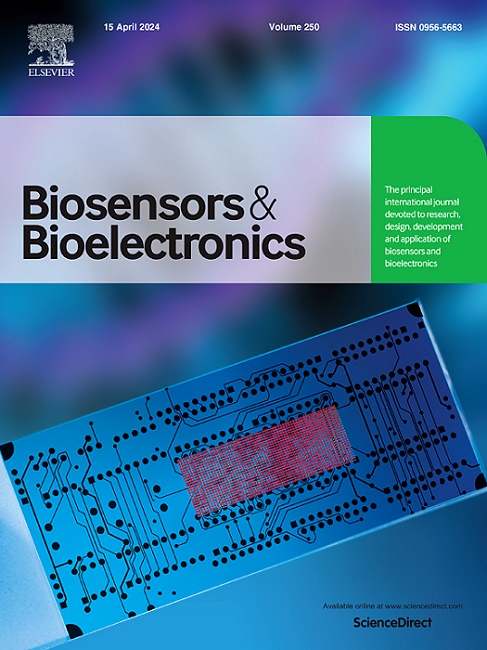基于TiO2/CdIn2S4/CdS的超分子水凝胶介导的电化学/电化学发光双模生物传感器灵敏检测恩诺沙星
IF 10.5
1区 生物学
Q1 BIOPHYSICS
引用次数: 0
摘要
基于TiO2/CdIn2S4/CdS (TO/CIS/CdS)复合材料和独特的超分子水凝胶猝灭探针,构建了一种新型光电化学(PEC)和电化学发光(ECL)双模生物传感器,用于恩诺沙星(ENR)的灵敏检测。首先,TO/CIS/CdS具有良好的PEC和ECL双信号,可用于双模传感和检测;通过循环扩增和磁分离技术,将目标ENR转化为含有ZnO纳米粒子(NPs)的大量产物链,并进行酸解得到锌离子。然后,利用单磷酸腺苷(AMP)与Zn2+的配体相互作用,在电极上形成一层具有良好生物相容性和稳定性的超分子水凝胶。水凝胶层较差的导电性和透光性使其成为PEC和ECL信号的优良双猝灭材料,用于ENR的灵敏双模检测。利用均匀溶液循环放大技术提高了检测灵敏度,同时避免了复杂的电极修饰过程,有效提高了传感器的工作效率和稳定性。PEC模式的检测范围为0.1 pg mL - 1 ~ 1 μ mL,检测限(LOD)为35 fg mL。ECL模式的检测范围为1 pg mL - 1 ~ 1 μ mL, LOD为0.14 pg mL。因此,利用TO/CIS/CS和独特的水凝胶猝灭剂,开辟了一种新型多功能生物传感器,在食品安全和环境监测领域具有巨大的应用潜力。本文章由计算机程序翻译,如有差异,请以英文原文为准。
Supramolecular hydrogel mediated photoelectrochemical/electrochemiluminescence dual-mode biosensor based on TiO2/CdIn2S4/CdS for sensitive detection of enrofloxacin
In this paper, a new photoelectrochemical (PEC) and electrochemiluminescence (ECL) dual-mode biosensor based on TiO2/CdIn2S4/CdS (TO/CIS/CdS) composite and a unique supramolecular hydrogel quenching probe was constructed for sensitive detection of enrofloxacin (ENR). Firstly, TO/CIS/CdS showed excellent PEC and ECL dual signals, which was applied to dual-mode sensing and detection. By using cyclic amplification and magnetic separation techniques, target ENR was converted into a large number of product chains with ZnO nanoparticles (NPs), and acidolysis was carried out to obtain zinc ions. Then, a layer of supramolecular hydrogel with good biocompatibility and stability was formed on the electrode using the ligand interaction between adenosine monophosphate (AMP) and Zn2+. The poor electrical conductivity and light transmission of the hydrogel layer make it an excellent double-quenching material for PEC and ECL signals, which was used for sensitive dual-mode detection of ENR. The cyclic amplification technique in a homogeneous solution was utilized to improve the sensitivity of detection while avoiding the complex electrode-modification process, thus effectively improving efficiency and stability of the sensor. The detection range of the PEC mode can reach 0.1 pg mL˗1 to 1 μg mL˗1, and the limit of detection (LOD) is 35 fg mL˗1. The detection range of the ECL mode is from 1 pg mL˗1 to 1 μg mL˗1, and the LOD is 0.14 pg mL˗1. Thus, a new multifunctional biosensor utilizing TO/CIS/CS and the unique hydrogel quencher was opened up, which has great potential for application in the field of food safety and environmental monitoring.
求助全文
通过发布文献求助,成功后即可免费获取论文全文。
去求助
来源期刊

Biosensors and Bioelectronics
工程技术-电化学
CiteScore
20.80
自引率
7.10%
发文量
1006
审稿时长
29 days
期刊介绍:
Biosensors & Bioelectronics, along with its open access companion journal Biosensors & Bioelectronics: X, is the leading international publication in the field of biosensors and bioelectronics. It covers research, design, development, and application of biosensors, which are analytical devices incorporating biological materials with physicochemical transducers. These devices, including sensors, DNA chips, electronic noses, and lab-on-a-chip, produce digital signals proportional to specific analytes. Examples include immunosensors and enzyme-based biosensors, applied in various fields such as medicine, environmental monitoring, and food industry. The journal also focuses on molecular and supramolecular structures for enhancing device performance.
 求助内容:
求助内容: 应助结果提醒方式:
应助结果提醒方式:


